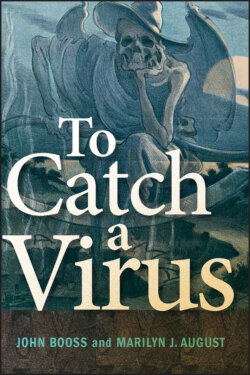Читать книгу To Catch a Virus - John Booss - Страница 14
Germ Theory
ОглавлениеSeeing with one’s own eyes is important for understanding the causation of infectious diseases. The microscopic or submicroscopic size of microbes was the root cause of centuries of misunderstanding of infectious diseases. For millennia, diseases were conceived as the work of demonic spirits, the wrath of God, or the miasmic emanations of decaying matter (40). These “invisible” microbes spawned massive epidemics and fear (Fig. 1). The reigning theoretical concept of disease causation was that of humoralism, of an imbalance of the four humors: blood, phlegm, black bile, and yellow bile. Interventions such as bleeding and purging were designed to restore the balance of the humors. The concept originated with Hippocrates and Galen and held sway for centuries (15). It did not account for microbes as the cause of infectious illness.
Figure 1 Specter of death waiting over Panama (U. J. Keppler, 1904). Yellow fever, which had been termed “the American Plague,” struck Philadelphia in 1793. It later threatened the construction of the Panama Canal, as shown in this cover illustration for Puck, a political satire and humor magazine. (Courtesy of Beinecke Rare Book and Manuscript Library, Yale University.)
doi:10.1128/9781555818586.ch1.f1
That is not to say that there weren’t glimmers of recognition of transmissible infectious agents. Girolamo Fracastoro (Fracastorius), whose poem about the shepherd Syphilis named that disease, wrote of its contagiousness in the 16th century (11). In his 1546 work On Contagion, he described germs as transmitters of disease (41), according to Garrison the first scientific statement on the nature of contagion (15). However, it was with the development of the first crucial piece of laboratory equipment, the microscope (4), that the particulate microbial nature of infectious diseases was visualized. With improved magnifying lenses introduced by Antony van Leeuwenhoek and Robert Hooke in the 17th century, it was finally possible to describe the microscopic world (16). van Leeuwenhoek called bacteria “animalcules” (Fig. 2).
Figure 2 van Leeuwenhoek exhibiting his microscopes for Catherine of England (painting by Pierre Brissaud). Leeuwenhoek first described bacteria viewed through his early microscopes as “animalcules.” (Courtesy of the National Library of Medicine.)
doi:10.1128/9781555818586.ch1.f2
In the 19th century, Louis Pasteur laid to rest the magical thinking implicit in an unseen world when he disproved the theory of spontaneous generation. This advance relied on a second crucial innovation: artificial growth medium in which microbes could visibly multiply. Pasteur’s swan-necked flask contained a growth-supportive fluid, which showed turbidity when exposed to the atmosphere and remained clear and uninfected when unexposed. Further, Pasteur’s studies with silkworms established the crucial concept that specific pathological conditions were associated with specific causes—a concept we now take for granted (12). After years of experimentation with the silkworm diseases pébrine and flacherie, Pasteur demonstrated their causation and means of prevention by eliminating the offending microbes.
Robert Koch, the genius who laid bare the specific causes of infectious diseases, refined the tools for laboratory diagnosis of infection (Fig. 3). He markedly facilitated the viewing of microbes through a microscope with the development of a substage condenser, a lens that concentrates light from the source through the object studied. The visualization of microbes was further enhanced through the application of histological stains to differentiate the organelles from other structures in specimens (5). With his development of photomicroscopic methods, Koch was able to share his observations, and it was a revelation when his first figures were published.
Figure 3 Robert Koch, about 1908. Koch developed the methodology that allowed the emergence of bacteriology as a science. In addition, he isolated the bacteria of tuberculosis and cholera, age-old scourges of humankind. (Courtesy of the National Library of Medicine.)
doi:10.1128/9781555818586.ch1.f3
Koch worked to improve another crucial laboratory tool, solid culture medium. Following the observation of the growth of bacteria on sliced potatoes and with the advice of Fannie Hesse, the wife of a physician working in his lab, Koch incorporated agar into nutrient broth and so created solid medium as a means of selectively growing bacteria (4). To this day, the growth and isolation of pure bacterial cultures on agar medium remain the standard of practice for microbiological research and diagnosis.
In his work on tuberculosis, Koch approached the vexing question of etiology. Koch’s postulates had their precedent in the work of Jacob Henle (10). While these tenets have evolved over time, Koch’s postulates are usually understood to include the following:
1 Regular isolation of an organism from the diseased organs and absence from healthy organs
2 Growth of the organism in pure culture
3 Recreation of disease on transmission to a susceptible host
4 Reisolation of the offending organism from the experimental host
Once it was possible to demonstrate the growth of microbes on artificial media and to see these microbes microscopically, the determination of the agents of specific infectious diseases simply exploded. These developments heralded the “golden age” of microbiology between 1877 and 1906 (Table 1). Koch revealed the age-old scourges of civilization, “Asiatic” cholera and consumption (tuberculosis), to be associated with specific organisms. Likewise, staphylococcus and streptococcus were identified as the causes of wound suppuration, limb amputation, and frequently death during wartime and after surgical procedures. A follow-on to the recognition of lethal bacterial wound contamination was Lister’s development of techniques for antiseptic surgery (22). The golden age was thus characterized by advances not only in laboratory techniques and demonstration of specific microbial causes of infections but also in the means to prevent those infections.
